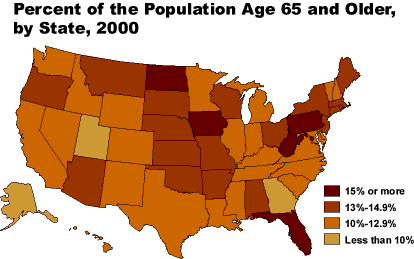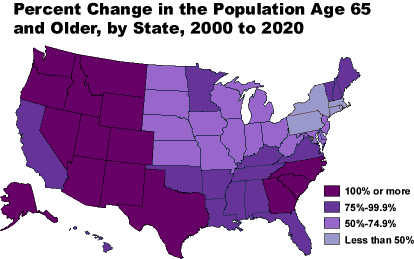
Baby-Boomer Retirees Changing the U.S. Landscape
Date
October 1, 2000
Author
(October 2000) People ages 65 and older are far less likely to move than their working-age counterparts. Still, those who do move tend to converge on a small number of “retirement magnets” — places that are especially attractive to the older population — and can have a significant demographic and social impact on an area. Florida, where older people make up an estimated 18 percent of the population in 2000, is the best example of a retirement magnet.
In states such as West Virginia, Pennsylvania, Iowa, and North Dakota, older people are also a growing share of the population, not because of migration but because of “aging in place.” Aging in place occurs when young people move elsewhere, leaving behind a relatively large percentage of people ages 65 and over. More states will begin to experience aging in place when the first baby boomers turn 65 in 2011.
The regional distribution and characteristics of future generations of older people therefore depend largely on the migration patterns of younger generations. Over the next 25 years, the older population is projected to double in several states in the Mountain West (Montana, Idaho, Wyoming, Colorado, New Mexico, Arizona, Utah, and Nevada); the Pacific Coast (Washington, Oregon, and Alaska); and the South (the Carolinas and Texas).


Citations
U.S. Census Bureau, “Projections of the Total Population of States, 1995 to 2025,” accessed online at www.census.gov/population/projections/state/stpjpop.txt on September 11, 2000; and U.S. Census Bureau , “Projections of the Population, by Age and Sex, of States: 1995 to 2025,” accessed online at www.census.gov/population/projections/state/stpjage.txt on September 11, 2000.
